Wondering how heavy the dumbbells you buy should be? Here’s your guide to choosing the right weight for your workouts.
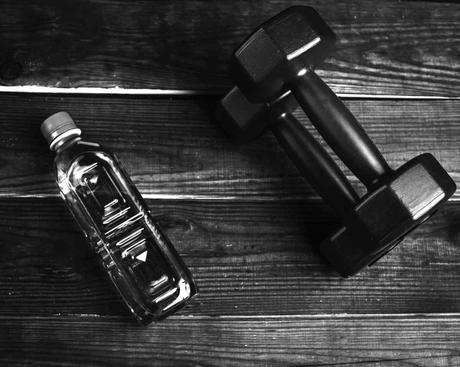
Dumbbells are one of the best investments you can make in your training goals.
Dumbbells are wildly versatile. They allow a more comfortable grip compared to bars and barbells. And they can be used for everything from powering up your spin workouts to sculpting some muscle.
In this article, we are going to cover everything you need to know about choosing the right weight for your dumbbells.
Including:
- How to choose the right weight for your dumbbells
- An overview of the different kinds of dumbbells
- When to increase the dumbbell weight
And more.
Let’s jump right in.
What kind of workouts are you going to do with dumbbells?
Dumbbells serve a variety of purposes.
And knowing what your goals are in the gym are crucial for choosing the right dumbbells to buy.
Related: 7 Best Dumbbells for Home Gyms
There are several different ways that you can train with dumbbells, including:




The dumbbells you end up buying will ultimately be a reflection of what your goals are with your workouts.
What are the different types of dumbbells?
While the function of a dumbbell is almost hilariously simple—be heavy—there are a TON of different kinds of dumbbells on the market.
Even for home gym enthusiasts, there is a lot out there.
Here is a quick overview of the different dumbbells:

The least expensive dumbbells for home gyms, they are made with cast iron and give you the familiar “clang and bang” sounds of your local gym.
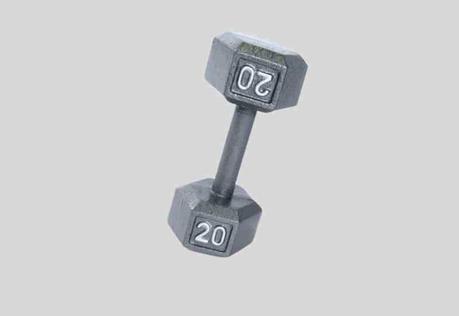
Cast iron dumbbells are the least accurate in terms of actual weight (I’ve seen iron DBs be off by over 10% in weight) because of air pockets that happen in the manufacturing process.
Nevertheless, for a basic dumbbell, these do the job great.

Easy to stack, almost always featuring a contoured handle for a superior grip, and inexpensive, rubber hex dumbbells are a killer choice for people building a home gym.
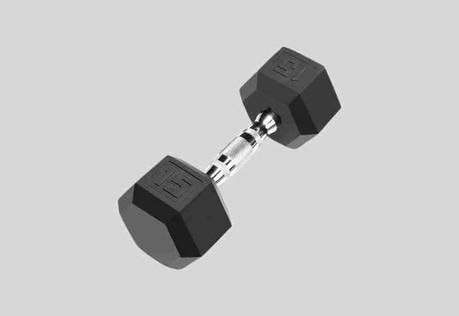
The rubber keeps noise to a minimum when dropping or racking.
Only downside is that they are usually made with recycled rubber which can be a bit stinky in small and enclosed spaces.

The options for adjustable dumbbells have absolutely exploded in recent years.
Resistance is generated in a variety of ways, including plate loaded dumbbells, pin and lock dumbbells (like the Powerblock Pro EXP dumbbells or the Bowflex 552’s) or a quick-lock system.
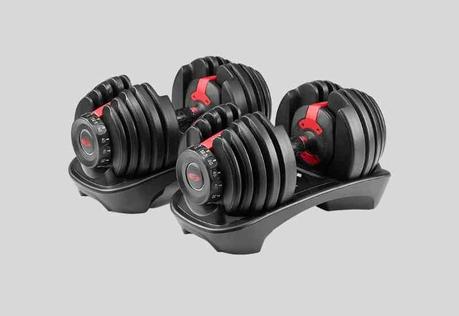
While they are more expensive up front, compared to a set of dumbbells they are far more cost-effective.
They are also a no-brainer for people who have a smaller workout area and don’t want a full rack of dumbbells.

Coated with the same material as a wetsuit, neoprene dumbbells are perfect for cardio-based workouts.
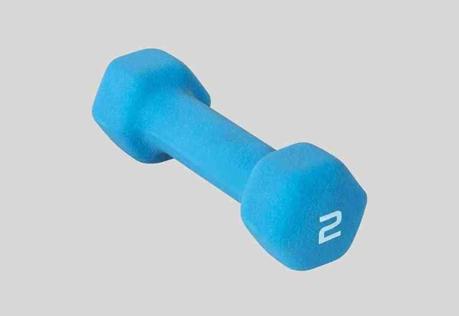
They are the same kind of dumbbells that you commonly find on the back of popular spin bikes like those made by Peloton.
The water-repelling material keeps your grip steady through your workout, no matter how sweaty you get on your spin bike or when going for a brisk walk.

These are the premium, commercial-grade dumbbells you will find in your local gym and at the training facilities of pro sports teams.
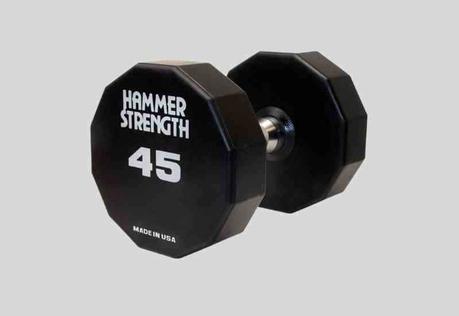
Urethane dumbbells are made for heavy-duty use, and people who lift at home love the fact that it doesn’t have the used-car-tire smell that rubber dumbbells frequently have.
They are the most expensive option and are the most accurate dumbbell in terms of weight variance.
When should you increase the weight of your dumbbells?
One of the most satisfying feelings when working out is leveling up in terms of performance and gains. That warm feeling of busting a new PB is kind of the best.
When you are able to easily lift a weight that you struggled with a couple of weeks ago, it’s time to level up and increase the weight of the dumbbells.
Why?
Because your body is an adaptation machine and requires the novelty of new stimuli to continue growing and strengthening.
Using the concept of progressive overload, there are two ways we can keep things moving forward:


But how do you know for sure when to escalate the weight resistance with your dumbbells?
As long as your technique and form are on point, if the last couple reps still feel easy-breezy, it’s time to crank up the weight.
A handy rule-of-thumb I’ve used over the years with clients and in my own workouts is to limit weekly progression to no more than 10%.
For example, if I am squatting 200lbs this week, I will try and lift between 200 and 220lbs next week.
This progression isn’t sustainable forever (obviously), but it provides a simple metric for people who are just starting to ramp up their weightlifting routine.
If you are unable to complete the designated reps for your set, or your technique is turning to mush, scale back the weight on the dumbbells.
Tips for Choosing the Right Dumbbells




The Bottom Line
Dumbbells are one of the best investments you can make for your training goals.
Whether you are looking to build muscle, lose weight, or simply get ridiculously strong, dumbbells—of all stripes—are the best way to get the job done.
Choose the right dumbbells for you, get to work, and chase down your workout goals.
More Dumbbell Guides and Articles
Looking for more information on dumbbells, including buyer’s guides to the best DBs for home and commercial gyms?
Check out the detailed articles below for more dumbbell-related information.
6 Best Dumbbell Sets for Every Kind of Home Workout. Looking for an awesome set of dumbbells for your home gym? Read on for a detailed review of the best dumbbell sets for working out at home.
6 Best Adjustable Dumbbells for Your Home Gym. Looking for the best adjustable dumbbells for taking your home workouts to the next level? Read on, because you’ve come to the right place.
6 Best Olympic Barbell Holders for Protecting and Storing Your Bars. Barbell holders protect your bar, open up more space in your home gym, and extend the life of your lifting gear. Here’s a breakdown of the best Olympic bar holders.
